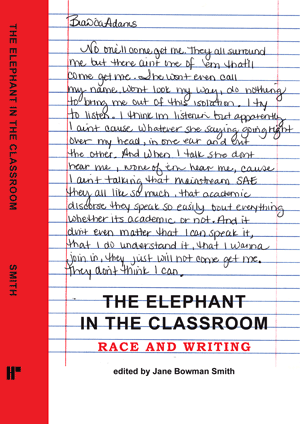The Elephant in the Classroom: Race and Writing (Jane Bowman Smith) | |
|  | Quantity in Basket:none
Code: 1-57273-895-2
Price:$23.95
Title: The Elephant in the Classroom
Sub-title: Race and Writing
Editor(s): Jane Bowman Smith
Publish Date: June 2010
Pages: 216
Format: Paper
| |
| While many works have been written about African American students and composition, they tend to examine the students themselves: their language, attitudes toward education, and successes and difficulties with writing. This collection examines the social construct of the classroom itself. African American students confront a complex situation in the composition classroom. Both their learning and their writing are made more difficult because in many instances, the instructor is White; while the instructor may have thought with some sensitivity about the problems African American students might face, he/she may not have thought critically about either his/her own “Whiteness” and its possible inpact on students or about the university as a “White” institution. When the language, the rhetoric, and the culture of some students is neither accepted nor understood by the instructor, and some traits are still stigmatized rather than seen as strengths, learning is made more difficult and in some cases impossible.
In examining the classroom as a social construct, chapters consider the academy’s traditions and expectations for writing and the teaching of writing; the role of Standard American English as a language that is typically privileged; the importance of understanding student writers; and ultimately, strategies and approaches that are more likely to help both instructors and students create a classroom community. Questions addressed include: Can one truly be “bidialectical” and “bicultural?” If so, how? Can both White and Black teachers as well as students begin to see the strengths of a blending of languages and cultures in academia? The university expects that students will come to it and change; however, to educate students respectfully and successfully, both the academy and individual instructors must be willing to listen and change with their students.
Contents: Introduction, Jane Bowman Smith. Negotiating Racial Relationships: Case Studies in Freshman Composition, Jane Bowman Smith. Room for the Unfamiliar: Thinking About the Tradition of Self-Reflection and the Construction of Consciousness in Black Community, William Jones. African-American Voice and Standard English, Arthur Palacas. Negotiating “Interference”: The Politics of Addressing Students’ Writing Patterns, Jennifer L. Kunka. How I Changed My Mind—Or, a Bidialecticist Changes Her Position, Allison Shaskan. Can You Re-present?, Richard W. Santana. Teacher Response to AAE Features in the Writing of College Students: A Case Study in the Social Construction of Error, Maureen T. Matarese and Chris M. Anson. Why Deny African-American Students a Choice We Offer Mainstream Students, Peter Elbow. Play That Funky Music . . . Black Man: Rhetoric, Popular Music and Race in the Classroom, Earnest Cox. Dabbling in the Abnormal: Blackening the Text in the Composition Classroom, Teresa Redd and Dorothy Perry Thompson. “We Are All Bound Up Together. Litasha Dennis and Kelly L. Richardson. Author Index. Subject Index.
|
| |







